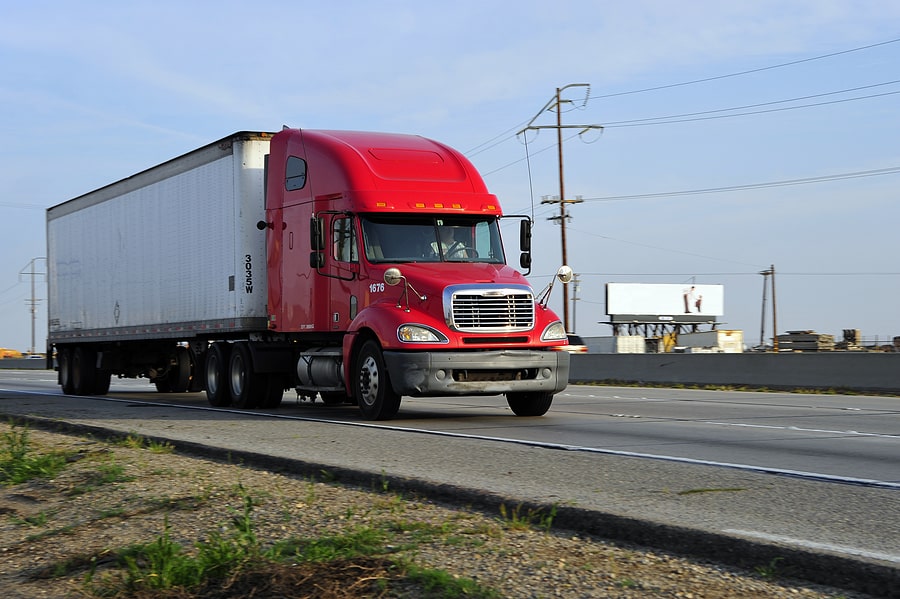Because of the weight of the truck, trailer, and cargo, you have a higher risk of suffering severe injuries, catastrophic injuries, or even death if you get into an accident with a tractor-trailer. Even when the truck is not hauling a trailer or hauling an empty trailer, its weight is significant enough to cause significant injuries and damage.
While you cannot avoid getting into an accident with an out-of-control tractor-trailer, the truck driver can avoid crashing into you by knowing where the tractor-trailer’s blind spots are and other facts about driving large vehicles.
Tractor-Trailers Have Blind Spots
Tractor-trailers are long vehicles – around 70 feet long if you include the truck and the trailer. Their length means that they have huge blind spots – and take wide right turns. This means that truck drivers must always know where other motorists are, regardless of the area they are operating the truck in.
The blind spots are not only on the sides of the truck. The front and rear also have blind spots; a trucker’s blind spot in front of the truck, for example, is at least 20 feet. This means that it’s that much easier for a truck driver to collide with another vehicle if they aren’t properly checking the space around their vehicle.
Trucks Must Maintain a Substantial Following Distance
It’s no surprise that the size and weight of tractor-trailers make stopping on a dime impossible; trucks must begin braking early and aggressively to avoid hitting obstacles ahead.
Unfortunately, this also means that vehicles ahead of the truck are in serious danger when truck drivers follow too closely. A truck driver might follow closer to a vehicle than they should. Sometimes they hesitate to brake to conserve fuel, or are rushing to meet a delivery deadline. Regardless of the reason, doing so means disaster for the vehicle (or vehicles) ahead should a leading vehicle need to reduce its speed when a tractor-trailer follows too close.
When a Tractor-Trailer Can Get Out of Control
Knowing the circumstances in which a tractor-trailer can careen out of control helps you avoid accidents. Sometimes, it is easy to tell when a truck might lose control, and other times, such as driving down a straight stretch of highway, it might be more difficult. When a tractor-trailer loses control, don’t expect just the front of the truck to hit you. The trailer could swing and swipe your car before you even know it.
Signs to look for include:
● Weaving while driving on a straight stretch of road. This may signal a fatigued driver. Once the trailer starts weaving, its weight could cause it to swing far to the right or left, or even jackknife.
● When a vehicle pulls in front of a tractor-trailer without leaving enough room for the driver to see it, the driver could slam the brakes on, causing the trailer to jackknife.
● If the roads are slippery with rain, snow, ice, or even an oil slick left by another vehicle, the traction wheels on the tractor could slide and make the trailer careen out of control or jackknife.
● High winds could tip a tractor-trailer over. If you are driving in high winds, give the truck a wide berth if you have to pass it. Also, stay at least 10 car lengths behind the truck. If it tips over, you need room to stop. If the roads are wet, it will take you longer to come to a stop.
● Sharp curves can also cause a truck to flip if the driver is going too fast for the curve. This type of accident usually happens on exit ramps with long curves. The curves do not look as sharp as they are, and a truck driver might take the curve too fast.
Truck Accident Injuries
In addition to the minor injuries you could suffer in a truck accident, you have a higher risk of severe or catastrophic injuries – or even death.
Injuries could include:
● Cuts, scrapes, bruises, scratches, and bumps.
● Strains and sprains.
● Pulled muscles, torn muscles, and other soft tissue injuries.
● Simple and compound fractures.
● Crushed bones.
● Face and eye injuries.
● Internal injuries.
● Head, neck, and shoulder injuries.
● Back and spinal cord injuries.
● Amputation of digits or limbs.
● Road rash.
● Thermal and chemical burns.
● Death.
You could also suffer from secondary injuries, such as infections, which could also be fatal. You are more likely to suffer from infections and other secondary injuries if you have diabetes, immunodeficiencies, or are taking medications that affect your immune system.
Recoverable Damages
After suffering injuries or losing a loved one in a truck accident, you could recover damages, including past and future medical expenses, therapy expenses, including physical therapy, occupational therapy, and cognitive and other psychological therapies, past and future lost wages, and funeral, burial and/or cremation expenses.
The defendant also pays to replace or repair any personal property damaged or destroyed in the accident.
You can also typically recover damages for pain and suffering, emotional distress, loss of use of a body part or bodily function, loss of quality of life, loss of companionship, loss of consortium, and inconvenience. If you suffered an amputation, burns, or other injuries that caused disfigurement or excessive scarring, you could also collect additional compensation.
After suffering injuries or losing a loved one in a truck accident, contact a truck accident attorney for a free case evaluation.



